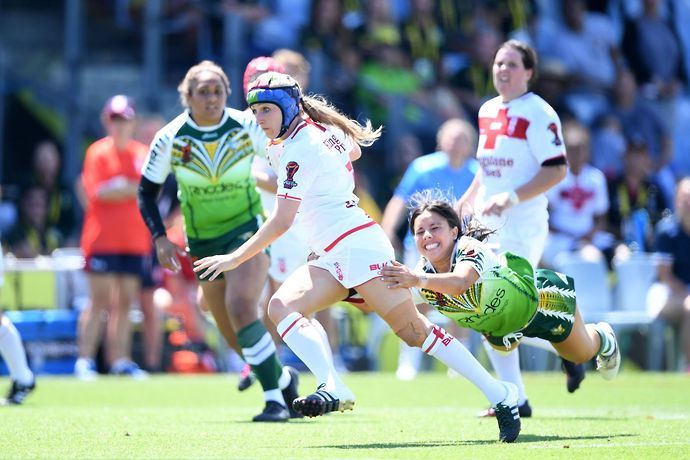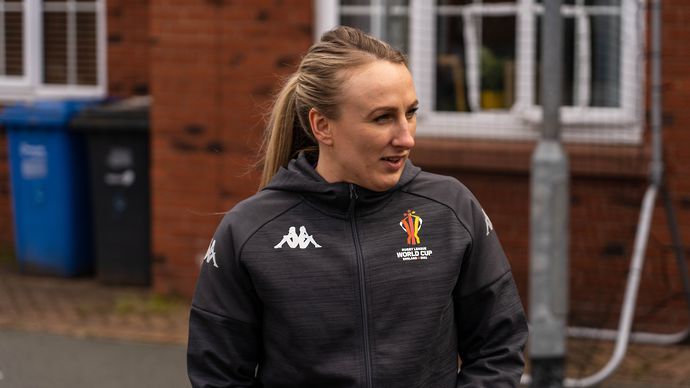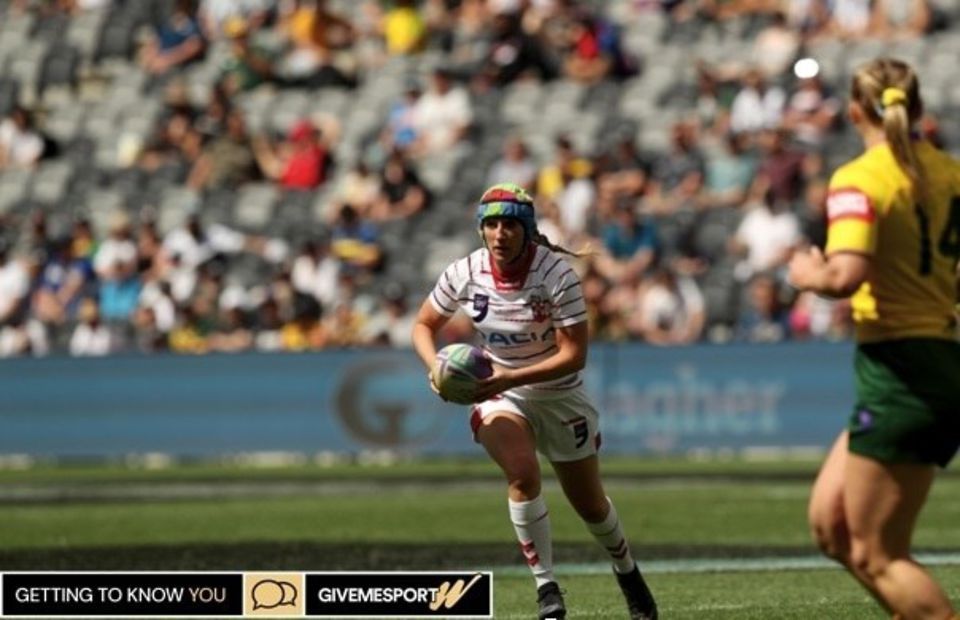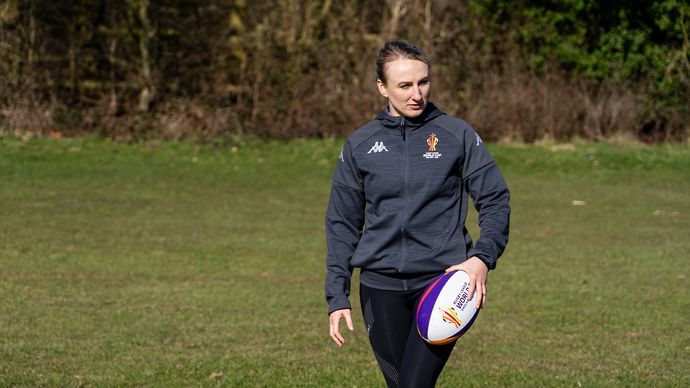It’s tough enough being a rugby league player. Countless hours of training, fitness, and match preparation would take its toll on any major athlete. Combining a full-time playing career with a full-time role as an ambassador would, therefore, seem inconceivable –– yet that’s exactly what Jodie Cunningham continues to do.A seasoned England international who’s featured at multiple major tournaments and also serves as an ambassador for the Rugby League World Cup, Cunningham speaks to GiveMeSport Women about her earliest memories, defining life decisions, and her fondest career highlight to date.Reminiscing about the first time she was first introduced to rugby league, Cunningham recalls a visit to Warrington Wolves’ old ground – the Wilderspool Stadium — with her father. It wasn’t an immediate fascination with the sport for the then eight-year-old though, as Cunningham reveals she wasn’t interested in the slightest.“I had no clue what rugby league was, and had never watched a game, so I’m pretty sure I didn’t really watch or pay attention to any of it,” she laughs. “I said ‘Dad, please never take me to that ever again’ –– something he does like to remind me about on a regular basis.” It wasn’t until an opportune moment at secondary school arose a few years later that Cunningham next considered the possibility of playing rugby. England captain and best friend Emily Rudge played the game already but had reached the age where she was no longer permitted to play with the boys, and so became intent on starting a girls’ team.Cunningham was sceptical at first. The prospect of playing was daunting, and she was unsure whether to try her hand at something so unfamiliar. It took just one session, however, for Cunningham to discover that steadfast connection.“It was the best decision I ever made, “ she stressed. “It was like I’d found that sport I should be playing, and then off the back of that, I fell in love with watching the game as well.”
It wasn’t until an opportune moment at secondary school arose a few years later that Cunningham next considered the possibility of playing rugby. England captain and best friend Emily Rudge played the game already but had reached the age where she was no longer permitted to play with the boys, and so became intent on starting a girls’ team.Cunningham was sceptical at first. The prospect of playing was daunting, and she was unsure whether to try her hand at something so unfamiliar. It took just one session, however, for Cunningham to discover that steadfast connection.“It was the best decision I ever made, “ she stressed. “It was like I’d found that sport I should be playing, and then off the back of that, I fell in love with watching the game as well.” But when was the moment she realised that a recreational hobby could become so much more? Initially, both Cunningham and Rudge were just playing locally, naive to the knowledge that women’s rugby league could become a profession.It was an additional session from a Warrington Wolves coach that eventually made the two aware of the feasibility of playing for England, and Cunningham recounts her immediate reaction.“That was a turning point for me because that wasn’t even a possibility that had entered my head. As soon as he said that women play and there’s an England team, I decided, right, that’s what I want to do.
But when was the moment she realised that a recreational hobby could become so much more? Initially, both Cunningham and Rudge were just playing locally, naive to the knowledge that women’s rugby league could become a profession.It was an additional session from a Warrington Wolves coach that eventually made the two aware of the feasibility of playing for England, and Cunningham recounts her immediate reaction.“That was a turning point for me because that wasn’t even a possibility that had entered my head. As soon as he said that women play and there’s an England team, I decided, right, that’s what I want to do.
I want to play for England. I want to play for England rugby league.
From that instant, Cunningham’s dream of playing rugby league for her country was fixed, and she hasn’t looked back since. The journey to international superstar has not been without difficult decisions, though, as the prospect of a career in medicine also weighed heavy on her mind when she first broke onto the England scene.
Cunningham had wanted to go into medicine but was advised that she’d struggle to commit to the course because of the hours she dedicated to rugby. Instead, she settled for studying biomedical science, intending to do medicine after –– but concedes she struggled to know where to focus.
“I never felt like I was fully committed to rugby because I had to find that 50/50 balance where I could do well enough at university and still do the training. The battle of knowing that I wasn’t really committed to either was a struggle for me, but luckily it worked out at the time.”
Indeed, Cunningham’s decision to juggle sport and medicine was ultimately validated as she succeeded at university and made England’s 2013 World Cup squad. It has been a career she is immensely proud of so far, but there is one specific highlight that stands out in her mind.
“That one moment for me is when I walked onto the field in the opening game of the 2017 World Cup for England’s match against Papua New Guinea,” she recalls.
A knee injury had kept Cunningham out of the game for almost six months, and she describes making the squad as nothing short of “a miracle.”
“During the national anthem, I was there like, ‘oh my god, I’ve done this, how have I got here?’ But then I came off and hadn’t thought about my knee once. There was just an immense pride and thankfulness towards all the coaching staff who got me there against all odds.”
Despite overcoming this injury setback, Cunningham was forced to take another sustained period away from the game after the tournament, as she continued to fully recover. It was this further period on the sidelines that eventually sparked an opportunity of a lifetime.
Having been asked to give a talk about her World Cup experiences, and the women’s game in general, Rugby League World Cup Chief Executive John Dutton told Cunningham they were on the hunt for an ambassador –– someone who could raise both the profile and visibility of the sport.
“Obviously I was 100% on board with everything he was saying, and I jumped at the chance to be an ambassador and represent the women’s game.”
It was a temporary role at first, filled with sporadic appearances to talk about the World Cup. But the opportunities soon spiralled and Cunningham came on the board permanently, assisting with community engagement and helping to roll out social impact programs across communities.
I would never have anticipated how fantastic being part of this [ambassador] team would be and how many doors, it would open for me. Hopefully it'll stand me in good stead for after the World Cup as well.
As an ambassador, Cunningham has been integral to the expansion of women’s rugby league in recent years, helping the sport to become more visible than ever before. Given the rapid growth, it’s understandably been difficult for Cunningham to adapt to life away from the field.
Like the majority of sports, women’s rugby league has been adversely impacted by the COVID-19 pandemic, but the overwhelming emotion for those involved within the game has been frustration.
“I think it’s because we had that real momentum, and the progress for the last three or four years has been outstanding,” Cunningham explained to GiveMeSport Women.
“There was more growth in those years than in the 34 years prior, and for me it's about making sure we don't lose that momentum because we were gathering so much support across the game.
“We can’t afford to let the women fall by the wayside. We have to make sure that, domestically, England are in the strongest position they can possibly be for this World Cup, to give us a chance to lift that trophy on home soil.”
This year, England will hope to better their World Cup performance from 2017, when they were comprehensively beaten by New Zealand in the semi-finals. Asked if the growth of the game, with more teams and players to pick from, could see England go one better, Cunningham was strong in her convictions.
“It was all we spoke about for a while. How do we go from a semi final squad that didn’t perform against New Zealand to winning a World Cup on home soil?
“As athletes, we've done a lot on what it takes to win a World Cup, and so we're in a much better place than we were before. We’ve got a lot of youth in our team, a lot of speed as well, and we’re doing absolutely everything we can to make sure that we’re ready.”
With around nine months to go until the World Cup is scheduled to get underway, the impending return of domestic rugby on 18th April is no doubt a huge boost for Cunningham and the rest of the England contingent.
There is more hope, more hunger, and more hallmarks for a World Cup triumph than ever before –– and, as Cunningham continues to promote and prepare for the biggest women’s rugby league event in history, the only thing left to do is bring home the ultimate prize.




















